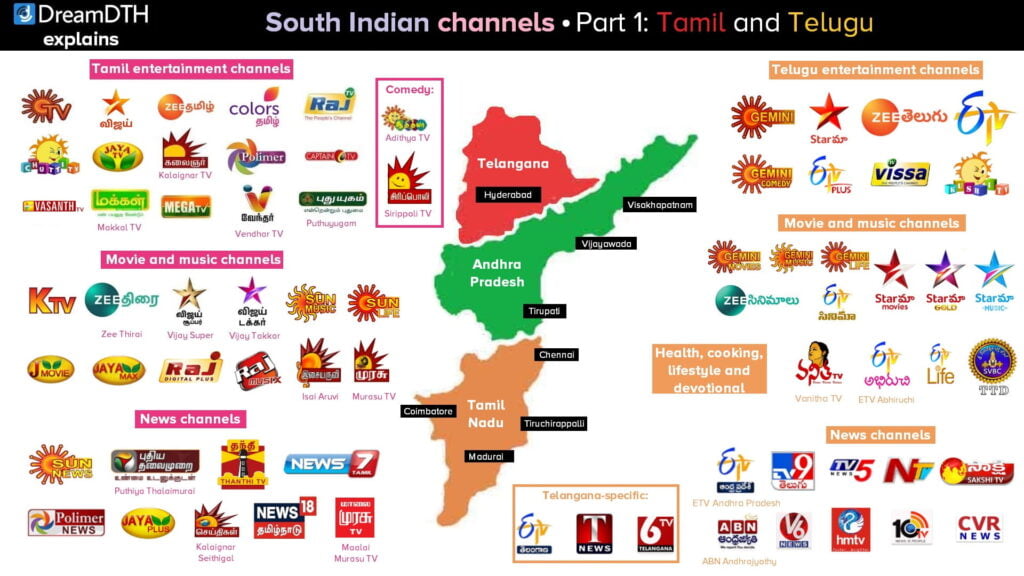After our two analytical pieces on the Zee–Sony merger and the contrasting futures of Disney Star and Reliance-owned Viacom18 and JioCinema, we return our focus to dealing with specific genres and languages of Indian TV channels. Having covered all major national channels under previous DreamDTH Explains articles, we now turn to regional (i.e., non-Hindi, non-English) channels under three broad areas of the country: South Indian (Tamil, Telugu, Kannada, Malayalam), East Indian (Bengali, Odia, Assamese, Bhojpuri) and West & North Indian (Marathi, Gujarati, Punjabi, Urdu) as will be dealt with in subsequent articles. Both national broadcasters like Star, Zee and Viacom18 and local ones like Sun, ETV and Manorama have had a strong presence in South Indian states, of which Sun later expanded to Bengali and Marathi TV, and also operates across the country in other sectors like radio and DTH.
Outside Hindi, South Indian channels have consistently had the largest viewership among Indian TV channels, especially Tamil and Telugu, with Sun TV (Tamil) and Star Maa (Telugu) being permanent members of the national top 5 channels in the BARC ratings, and Star Vijay (Tamil) and Zee Telugu also featuring in the top 10. South Indian GECs (general entertainment channels) are driven by not only series and reality shows but also by big-ticket movie premieres — which is nowadays almost never the case in Hindi, where movies are strictly confined to dedicated movie channels. As such, the four South Indian languages occupy the great majority of non-Hindi viewership in the country — though Malayalam has a smaller percentage than the other three — and therefore it is only proper that we discuss them before other regional languages.
Due to the immense number and influence of Tamil and Telugu channels compared to the other two South Indian languages, this article has been split into two parts: this instalment discusses Tamil and Telugu channels, and the next instalment goes over Kannada and Malayalam channels.
General overview of South Indian TV broadcasters
Owned by businessman Kalanithi Maran, the Sun network is the oldest and biggest broadcaster in South India, covering all four languages, and in recent years it also launched Sun Bangla and Sun Marathi. Its flagship, Sun TV, is unquestionably not only the number one Tamil channel but also one of the top-ranked channels in India overall as per the weekly BARC ratings. However, its other three main GECs — Gemini TV (Telugu), Udaya TV (Kannada) and Surya TV (Malayalam) — are suffering badly at the hands of Disney Star and Zee channels. Sun has a large bouquet of movie, music, comedy and kids’ channels in all four languages plus many HD channels, as we discuss in the section on Tamil channels, in addition to Sun News in Tamil.
ETV (Eenadu TV) in Telugu is the other South Indian broadcaster with a longstanding presence since the 1990s, with multiple entertainment, movie, news and niche channels in Telugu including several HD channels. It operated in several non-Telugu languages until 2014–15, when they were sold to Reliance and rebranded as either Colors or News18. ETV now operates the ETV Bal Bharat kids’ channels across 12 languages including Telugu, which launched in 2021, though several were later closed. In Kerala, the long-established Malayala Manorama publishing group operates Mazhavil Manorama, launched in 2011, which is one of the biggest Malayalam GECs, while another popular GEC, Flowers TV, was launched in 2015 and quickly became an important force to reckon with in Kerala.
Disney Star and Zee are also present in all four languages, as is Viacom18 in Tamil and Kannada but not the other two. Star Maa is the undisputed leader of the Telugu segment — consistently achieving a top-5 nationwide ranking alongside Star Plus, its Hindi counterpart, and Sun TV — while Asianet, Star’s Malayalam flagship, has ruled Kerala for decades on end. Star Vijay in Tamil, while not as dominant as Sun TV, does have a decent viewership, also appearing in the BARC national top 10. Star Suvarna, however, trails behind its competitors from Zee and Viacom18. Coming to Zee, only Zee Kannada is a leader out of its four South Indian GECs, with Viacom18’s Colors Kannada and Star Suvarna trailing, while Zee Tamil, Zee Telugu and Zee Keralam are close behind the corresponding Star channels. Viacom18 used to rule Karnataka through Colors Kannada and the secondary Colors Super, but Zee Kannada has overtaken it, and its other South Indian GEC Colors Tamil is not especially popular.
Quirks and peculiarities: language-specific broadcasters in each state
There are many quirks and peculiarities of South Indian channels that distinguish it from other languages. For example, unique to South India is the concept of so-called ‘comedy channels’, which show comedy clips from movies — a concept that does not exist in north Indian states. Such channels are mostly from the Sun network: Adithya TV (Tamil), Gemini Comedy (Telugu), Udaya Comedy (Kannada) and Surya Comedy (Malayalam), while the Tamil-language Kalaignar network also has Sirippoli TV for this purpose. (Though the Telugu-language ETV Plus is also a comedy channel, it does not show such comedy clips, instead showing fun-filled reality shows like Jabardasth and several movies.)
Tamil, in particular, has a disproportionately high number of local broadcasters outside the big national or multi-state players like Sun, Star, Zee and Viacom18 — and many of these networks are owned by, or have dealings with, political parties. Such broadcasters include Jaya, Kalaignar, Raj, Polimer, Mega, Vasanth, Vendhar and Captain, among many others, which operate in not only the main GEC and news genres but often also others like kids’, movies and music. (Raj is the only one of these to operate outside Tamil Nadu, though some of its non-Tamil South Indian channels have now been sold to other companies.) Nevertheless, all the small Tamil broadcasters have an almost negligible viewership compared to the biggest channels: Sun TV, Star Vijay and Zee Tamil.
Malayalam (whose main local broadcaster is Malayala Manorama, which owns the Mazhavil Manorama entertainment channel and Manorama News) also has a handful of such channels, like Amrita, Kairali, Kaumudy, Jeevan, Jaihind and Janam — many of which also have political affiliations — but they are not as large as their Tamil counterparts. In contrast, the Telugu-speaking states of Telangana and Andhra Pradesh have only one major local broadcaster, ETV (Eenadu TV) — with as many as 11 Telugu channels, over and above the ETV Bal Bharat kids’ channels in 11 other languages — and much fewer non-news channels outside the big national broadcasters. Similar is the case with Kannada, where Kasthuri and Siri Kannada are among the very few general entertainment channels outside the big networks, and Public TV, a news channel, later launched Public Movies and Public Music.
In terms of news channels, Tamil, Telugu and Kannada all have more than 15 satellite news channels each, but this is not the case for Malayalam, which has fewer than 10. In addition to national players like News18 and TV9 — with Zee Media operating digital-only news channels before launching satellite news channels in Kannada and Telugu — there are several important local news channels like Puthiya Thalaimurai and News 7 Tamil in Tamil, sister channels Asianet News and Suvarna News (no relation to Star) in Malayalam and Kannada respectively, and a handful more news channels in Telugu like NTV Telugu, TV5 Telugu and CVR News, which all operate a couple of non-news channels in genres like devotional. Several of these news channels are owned by newspapers, which is also often seen in the rest of India: Thanthi TV and Maalai Murasu TV in Tamil; Sakshi TV, HMTV and ABN Andhrajyothy in Telugu; Prajaa News in Kannada — also previously Dighvijay News before being sold to Republic Media Network and rebranding as Republic Kannada — and Manorama News and Mathrubhumi News in Malayalam.
With this general background, we will now begin our analysis of the major broadcasters in each of these languages, with Tamil and Telugu in this instalment and Kannada and Malayalam in the next. We start with Tamil, the most important regional language in not only South India but the entire country — in terms of the vast number of channels it has and the large population it serves. On a pan-Indian level, Tamil is not as popular in terms of its movie output as Telugu and more recently Kannada, but its film industry is known for blockbusters like Jailer, Leo and Ponniyin Selvan: I and II that make big business in Tamil Nadu and overseas — running into hundreds of crores of rupees — if not other Indian states.









1 reply
Loading new replies...
Join the full discussion at the DreamDTH Forums →